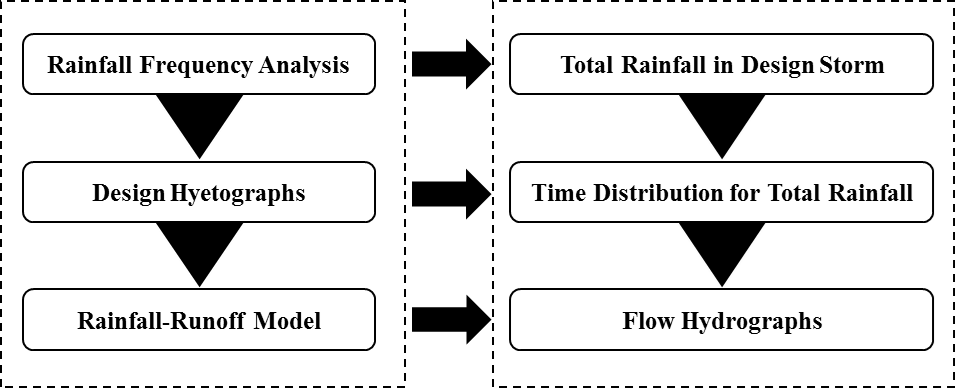-
River Width Formulation
Since the river width normally affect the capability of flood conveyance, the formulation of river widths plays an important role in river regulation planning. The required river width, now, is determined by using empirical formulas which can estimate the river width that is capable of successfully convey the flood and stabilize the scouring and silting.
-
Hydrological Design and Analysis
In the design of hydraulic engineering practice, it is necessary to evaluate the impact of different hydrological events on the catchment in order to determine the appropriate hydrological design level as the basis for the subsequent hydraulic construction projects and watershed management. This decision process is called hydrological design. Three approaches are commonly used to determine a hydrologic design value: 1.Empirical approach, 2.Risk analysis, and 3.Hydroeconomic analysis.
At the moment, the hydrological return periods in rivers and drainage planning in Taiwan are based on the principle of risk and economic analysis. For those with large flooding losses, higher design return periods are adopted. These return periods are usually calculated by frequency analysis. Hydraulic engineering structures are required to be safe under this design flow condition. Generally, different hydraulic structures or planning may have different design return periods. Some commonly used design return periods can refer to Table 1. However, if the relevant authority has other regulations, it should be complied with.
Table 1: Design return period in different area
| Flood Control Category |
Design Return Period |
| Urban Drainage |
2~5year |
| Road Drainage |
5~100 year |
| Farmland Drainage |
5~10 year |
| Regional Drainage |
Plain |
10 year |
| Mountain |
25 year |
| River Administered by Local Government |
25~50 year |
| River Administered by Central Government |
100 year or 200 year
(200 years is for the most densely populated river, such as Tamsui River) |
-
Present Hydrological Analysis Procedure
The design return period and suitable design method should be determined in the very first step in order to analyze the planning discharge. As shown in Table 1, the return period is designed on the basis of protected object or project purpose. Therefore, hydraulics engineers should select a proper protection standard according to project purpose.
When it comes to the analysis of planning discharge, a couple of methods are utilized in Taiwan, observed discharge frequency analysis and the method by coupling design storm and rainfall-runoff model. The former one requires long term flow discharge records, which are mostly insufficient in Taiwan, to evaluate reliable different return period flow discharge. Most of the present planning discharge are designed by the latter one. Since the rain gauge are deployed all over the place in Taiwan and have sufficient records, one can design a specific precipitation event, which is called design storm, by analyzing the long term rainfall data extracted from rain gauge. By setting the design storm as an input, the rainfall-runoff model can perform the runoff process. Then the planning flow discharge is determined. The concept of combing design storm and rainfall-runoff model is briefly illustrated by the Figure 1 as follows.

Figure.1 Procedure of designing planning discharge
-
Project Evaluation
Flood control is the use of engineering practice, regulation measures and other comprehensive measures to reduce flood disasters. By utilizing flood control measures may increase land use and enhance the public benefits which is the so called flood control benefits. The benefits of the project can be divided into measurable benefits and uncountable benefits. The measurable benefits are the benefits that can be measured by money and can be divided into direct and indirect benefits and other additional benefits. The general benefit analysis of flood control projects is based on the measurable benefits. Nevertheless, the intangible benefits data that cannot be counted should still be collected for decision-making.